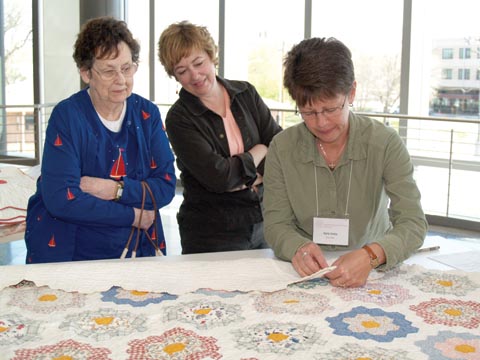| |
|
|

from the issue of May 8, 2008
|

| |
|
|
| |
Crews

Tracing family heritage (in stitches)

BY TROY FEDDERSON, UNIVERSITY COMMUNICATIONS
Laurie Bellows has always been fond of quilts.

| | 
 
| | | QUILT STUDY - (From left) Beulah and Laurie Bellows watch as Karla Salda, an IQSC volunteer, sews a muslin documentation label onto the back of a family quilt during the May 3 Quilt ID Day event. Photo by Troy Fedderson/University Communications.

|
She remembers waking up as a child wrapped in a "big, old heavy farm quilt" on cold mornings. She made a baby quilt in high school - a one-time sojourn into quilting as it took "an incredible amount of time." She even used a quilt, a gift from a friend, until it fell apart.

Still, it took the April 17 Nebraska Lecture by Patricia Crews, director of the International Quilt Study Center and Museum, to get Bellows seriously interested in her family quilts.

"I went to listen to Patricia Crews and was amazed at how the International Quilt Study Center can date quilts by the type of thread and material used," said Bellows, professor of practice with graduate studies. "Afterward, I started thinking it would be neat to get some of my mother's quilts looked at."

Her mother, Beulah Bellows, had been trying to give some family quilts to Laurie for about a year. When Laurie mentioned taking the quilts for an examination, Beulah got them ready.

A graduate studies coworker, Jane Schneider, told Laurie to contact Carolyn Ducey, curator of collections for textiles, clothing and design. Ducey, in turn, alerted Laurie to the quilt identification day on May 3. Laurie quickly signed up for one of the open appointments.

The quilt center hosts four Quilt ID Days each year. Individuals are allowed to bring in two quilts for examination. Center faculty, staff and volunteers take photos of each quilt and provide preservation tips. Information about the design, year created, the quilter and owner is written on a paper form and a muslin documentation label. The muslin label can be sewn onto the back of the quilt.

"A lot of people that come in, know a lot about their quilts," said Ducey. "But, they want to get documentation. That's the important part because it will be passed down to future generations."

Beulah and Laurie Bellows knew a little bit of information about their quilts. A "friend" of Laurie's grandmother handed two of the three down.

"Her name was Beulah too," said Laurie. "I asked my mom who she was, and she said Beulah was a friend, possibly an aunt."

 
| | HISTORY STITCH - The muslin documentation labels made during Quilt ID Day include information about the quilt. Photo by Troy Fedderson/University Communications.

| |
Laurie took that information and turned it over to another graduate studies coworker, Eva Bachman, who does genealogy work in her spare time. Bachman traced the information through census data, finding a Beulah Cole who lived with Laurie's great grandparents in 1900.

"It turned out that Beulah was my grandmother's cousin," said Laurie. "She came to live with my great-grandparents when her mother passed away."

When Laurie passed the information to her mother, memories flowed.

"My mom never referred to Beulah as a cousin, but she remembered an Uncle Nathan who was Beulah's father," Laurie Bellows said. "She also remembered that my grandmother and Beulah were very close. So much so that my grandmother named my mother after Beulah."

Laurie and her mother brought three quilts to the identification event. The two from Beulah Cole were dated to the 1930s.

"That puts the quilts at the time Beulah would have had them," Laurie said. "Every quilt has a story. And, for us, it has been nice tracking down this background information to pass on to our family."

They also learned another valuable lesson.

"We brought the quilts here in plastic bags," Laurie said. "That's a no-no when it comes to quilt preservation. Our next stop is to buy some pillowcases to store our quilts. Now that we have all this information, we want to be sure to keep these quilts safe."

GO TO: ISSUE OF MAY 8
NEWS HEADLINES FOR MAY 8
Tracing family heritage (in stitches)
2,400+ to collect degrees
Future bright for digital humanities projects
Selenium research lauded
Building to bring physics, astronomy together
Campus Rec creates campus walking maps
733170S38230X
|
|
|
|
|
|
|
|